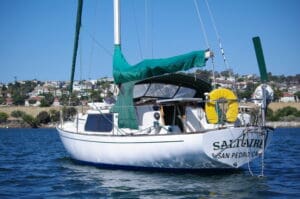by Bill Morris

No matter how hard the wind blows, a windvane self-steering system is your vessel’s round-the-clock helmsman. So it makes good sense to maintain the vane gear in top condition at all times. Performing the following procedures will keep your windvane steering system functioning properly with fewer hassles and will aid you in making major repairs in the unlikely event that something goes awry while under sail.
Inspection
Your predeparture checklist starts with checking all fasteners, which should be snug, particularly at the mounting brackets. Large rings of brown rust around bolt heads or nuts indicate a loose stainless steel fastener and obviously some corrosion. All stainless fasteners should be rated 316L.
Inspect the rest of the unit carefully for thin cracks, the telltales of crevice corrosion, especially in stainless welds and at the undersides of mounting tubes. Such seemingly harmless lines of rust may hold up in fair weather, but imagine what extreme torsion can do to the windvane’s mounting tubes during a week-long full gale in mid-Atlantic in January, surfing down 20-foot seas. Yikes!
Check turning blocks, fixed blocks and fairleads to ensure the sheaves turn smoothly. Also run the steering lines, if any, through the blocks to make sure there is nothing impeding the lines’ paths on the way to the helm. Finally, make sure the steering line attachment system at the tiller or wheel (which must be mechanical, not hydraulic) is firmly installed, with no play in the fasteners.
Bushings, bearings and sleeves
Assemble a set of whatever hardware you may need to replace after crossing a couple of oceans, including nylon or Delrin bushings, bearings and sleeves. To remove a bushing or bearing race, first remove the set screw. On some models, you may need to use a pair of special pliers to remove circlips or spring clips at the top of the vane turret.
Remember to secure the circlip with a string through one of its eyes to keep it from ricocheting through the mast orchard. When disassembling bevel (pinion) gears to inspect the teeth or access bearings, mark the bronze or stainless surface with an indelible marker for easy reassembly.
Reassembling a vane turret with its new bearings does not have to be a nerve-wracking experience. A thick dowel through the turret will make the job a lot easier. Hans Bernwall, founder of Scanmar International, suggested using shaving cream to keep bearings in place during reassembly of the Monitor vane turret. After finishing the job, simply rinse the unit with a water hose to remove the shaving cream. Also, remember to use Loctite on setscrews and other fasteners to keep bearings from coming loose.
Blocks and control lines
Permanently riveted blocks with polymer bearings and sheaves do not permit any sort of maintenance aside from washing in freshwater. When they wear out, replace them and use the old ones for less demanding jobs.
Higher-grade blocks may be disassembled and even fitted with new plastic bearings. Use caution in reassembling these units; they commonly contain two sizes of bearings in concentric grooves on either side of the sheave.
The likelihood of encountering metal bearings in swivel blocks these days is slim, but if you do, clean them with kerosene or diesel, not gasoline, which is extremely volatile. Better yet, throw them away and replace with high-quality blocks with stainless or aluminum cheeks and high-density plastic sheeves and bearings, such as those offered by Ronstan, Harken, and Garhauer.
Control lines are the weakest link in any servopendulum (e.g., Monitor, Sailomat, Fleming) self-steering installation. Thin, double-braided polyester line takes a beating while passing over sheaves millions of times during an ocean crossing. Verify the line diameter matches the blocks; servopendulum builders recommend ¼-inch to 3/8-inch line, depending on the model. Overly thick line will not move freely through the cheeks and will begin to fray early in your next passage.
Damaged windvane structure
Only a qualified welder can carry out repairs on broken welds or split tubing on stainless steel or aluminum. For stainless, make sure the welder is using a tungsten inert gas (TIG) outfit to ensure a clean, professional weld. Brazing with a brass rod is not hot enough and will only make a bigger mess for the next welder to clean up and repair. Unshielded arc welding, or stick welding with regular steel rods, is also inadequate.
Welding aluminum requires a great deal of skill. Excessive heat can cause annealing, which weakens the affected metal and ultimately leads to structural failure under extreme loads. TIG works well for aluminum as well. When welding pieces 1/4-inch or more in thickness, the welder should use gas metal arc welding (MIG), which incorporates a wire feed to fill in the deep crevice between the welded edges.
For a loose or wobbly mounting system, you can reinforce the vane gear mast and mounting tubes with rigging wire and turnbuckles attached to the stern pulpit or some other solid structure. With a Swage-It tool, a handful of thimbles and ferrules, small turnbuckles and a coil of used halyard wire, you can create all sorts of expedient rigging, including jib pendants and hold-downs for propane tanks and other equipment that must be fastened solidly to some surface.
With proper use and maintenance, your windvane self-steering system should serve well throughout your entire cruising career. Check the unit often, keep a constant eye on the steering lines and enjoy a fun, uneventful ocean crossing.
Circumnavigator-author Bill Morris believes the best strategy for succeeding as an offshore voyager is to keep systems simple and, if possible, manual. Key to survival are a windvane self-steering system, a basic array of electronics and an aggressive alternative energy battery charging matrix. Bill is a contributing editor to Ocean Navigator and the author of The Windvane Self-Steering Handbook (International Marine, 2004) and The Captain’s Guide to Alternative Energy Afloat (Seaworthy Publications, 2019).

